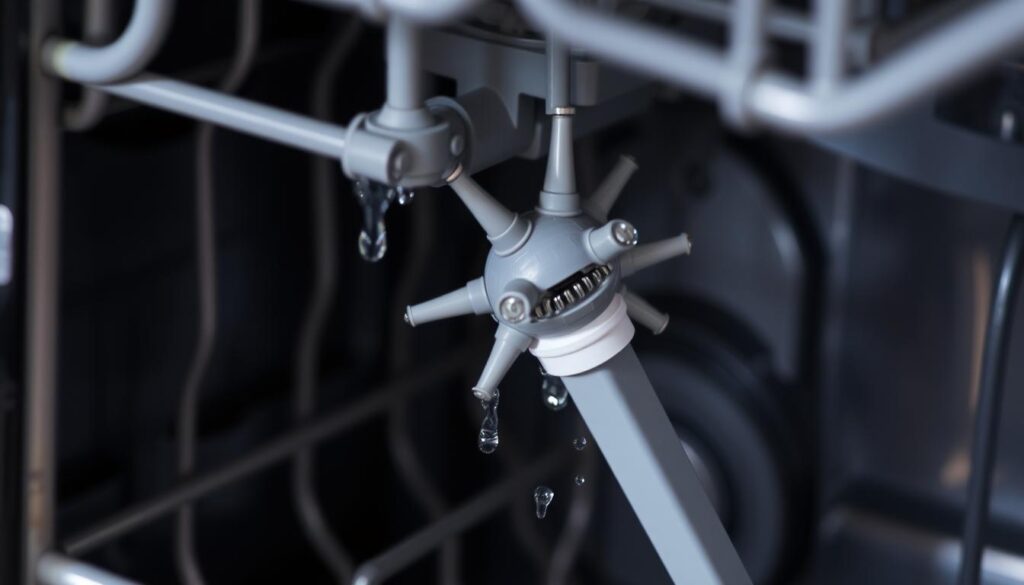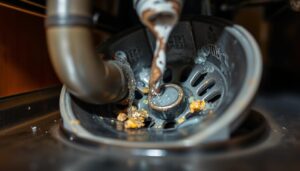Are you frustrated with your dishwasher’s inability to clean your dishes properly? The issue might lie with the spray arm that’s not rotating as it should.
When the spray arms don’t spin, your dishwasher struggles to distribute water effectively, leading to poor washing results. But what causes this problem, and how can you resolve it?
Understanding the relationship between the circulation pump, water pressure, and spray arm movement is crucial to identifying the root cause of the issue.
Key Takeaways
- Identify why your dishwasher’s spray arms are not spinning and the impact on washing results.
- Learn a comprehensive troubleshooting process to diagnose the issue.
- Understand the role of the circulation pump and water pressure in spray arm movement.
- Discover step-by-step solutions, from DIY fixes to complex repairs.
- Know when to attempt repairs yourself and when to call a professional.
Why Your Dishwasher Spray Arms Need to Spin
The effectiveness of your dishwasher relies heavily on the proper functioning of its spray arms. For dishes to be thoroughly cleaned, water must be distributed evenly throughout the dishwasher.
Mechanics Behind Clean Dishes
The spray arms are designed to rotate due to the water pressure pushing against the nozzles, creating a spinning motion. This motion ensures that water reaches all areas of the dishwasher, including the corners and spaces between stacked items.
The rotation of the spray arms is crucial for effective cleaning. Here are some key points to understand:
- Rotating spray arms create the necessary water pressure and distribution pattern to clean all surfaces of your dishes.
- The engineering design allows spray arms to propel themselves through water pressure while cleaning your dishes.
- The spinning motion ensures water reaches all areas, including corners and spaces between stacked items.
| Spray Arm Status | Cleaning Performance |
|---|---|
| Rotating | Effective cleaning, evenly distributed water |
| Static/Stuck | Poor cleaning, water not distributed evenly |
Understanding how your dishwasher’s spray arms work can help you identify issues and maintain optimal performance.
Common Signs of Spray Arm Problems
Dishes not getting clean? The culprit might be your dishwasher’s spray arms not functioning correctly. When your dishes come out of the washer less than sparkling, you investigate why.
Recognising the Issue
If it seems like your dishes are being washed unevenly or barely washed at all, the trouble could be with your spray arms. Here are some signs to look out for:
- Food residue remaining on dishes after a complete wash cycle.
- A distinctive pattern of poor cleaning that indicates spray arms aren’t spinning properly.
- Unusual sounds during the wash cycle that might indicate spray arm malfunction.
To diagnose the issue, you can perform a quick visual inspection during the wash cycle (if your dishwasher has a window) to check if spray arms are rotating.
| Signs | Possible Causes |
|---|---|
| Food residue on dishes | Clogged spray arms |
| Uneven cleaning | Spray arms not spinning |
| Unusual sounds | Malfunctioning spray arm |
Safety Precautions Before You Begin
Before you start repairing your dishwasher, it’s crucial to take necessary safety precautions to avoid any potential hazards.
Essential Safety Measures
To ensure your safety during the repair, make sure to disconnect the power to the dishwasher before accessing any internal components. It’s also recommended to turn off the water supply to prevent any accidental leaks or water damage.
- Disconnect power at the circuit breaker to prevent electrical shock.
- Turn off the water supply to avoid leaks and water damage.
- Wear protective equipment like gloves when handling potentially sharp or dirty parts.
- Position your dishwasher safely to access internal components without risking injury.
- Read your specific dishwasher model’s manual before attempting any repairs to understand its unique requirements.
By following these safety precautions, you can ensure a safe and successful dishwasher repair experience.
| Safety Precaution | Importance |
|---|---|
| Disconnect Power | High |
| Turn Off Water Supply | High |
| Wear Protective Gear | Medium |
Tools You’ll Need for Dishwasher Repair
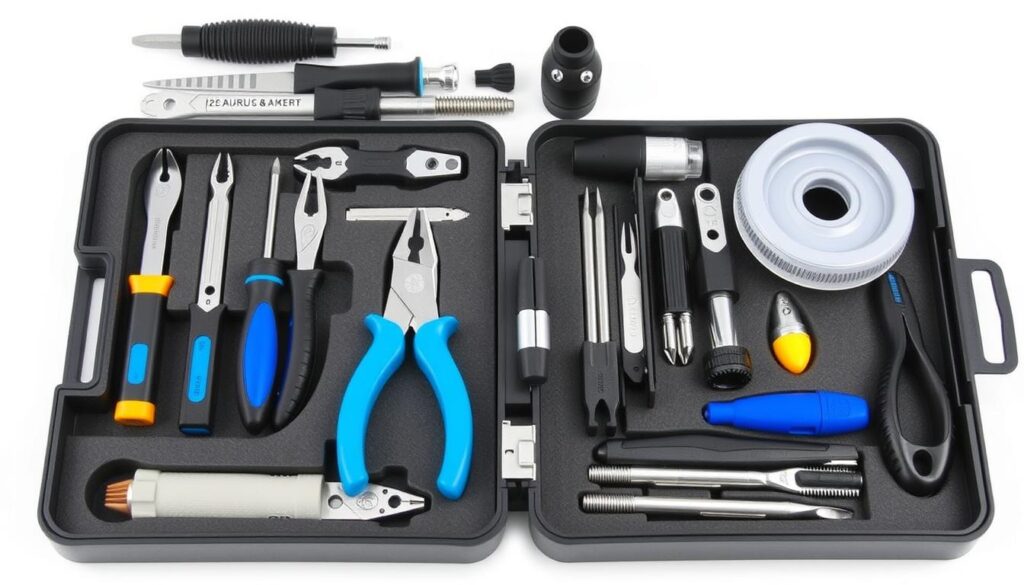
The first step in diagnosing and fixing issues with your dishwasher’s spray arm is to assemble the necessary tools.
Gathering the Right Equipment
To effectively repair your dishwasher’s spray arm, you’ll need a few basic tools. A straightened paper clip or safety pin can be used to clear blockages from the sprayer arm’s tiny nozzles by poking the tip into each nozzle to break away mineral scale caps.
- Basic tools for diagnosing and fixing issues
- Household items for clearing spray arm blockages
- Specialised tools for accessing hard-to-reach components
- Safe cleaning solutions and materials
- Efficient workspace organisation
Having the right tools and a well-organised workspace will make the repair process smoother.
Check for Physical Obstructions First
Make sure the dishwasher’s spray arms can rotate freely. Before starting a cycle, manually rotate the spray arms to ensure they spin without hitting anything.
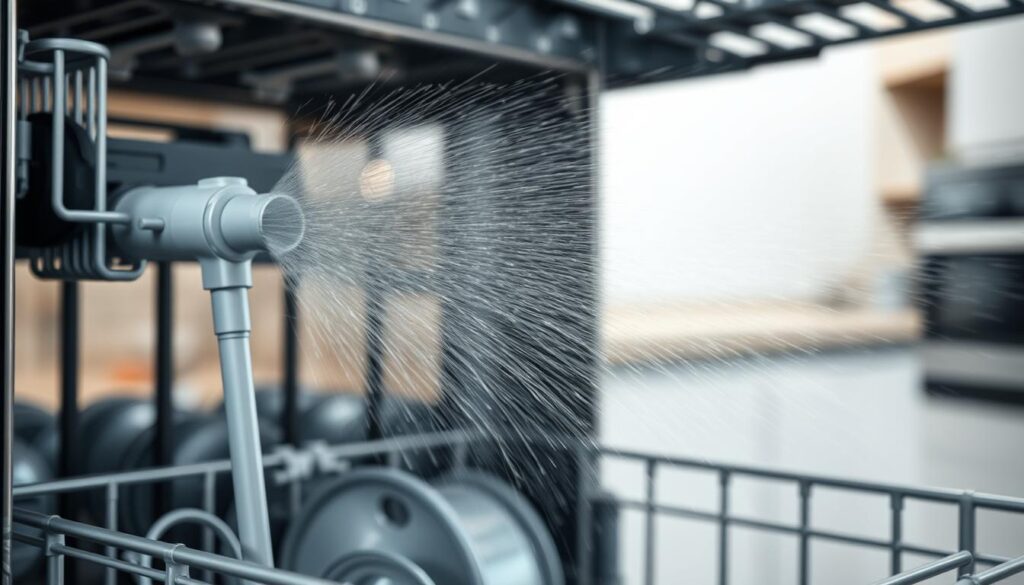
Simple Checks for Common Issues
Improper loading of dishes and utensils can prevent the spray arms from spinning. Check for tall utensils or oversized dishes that might be obstructing the arms. Remove or reposition any items that stop the spray arms from spinning.
- Inspect your dishwasher for items that might be physically blocking the spray arms.
- Understand how to adjust your dishwasher loading habits to prevent future obstructions.
- Learn the correct technique for manually testing spray arm rotation.
By following these steps, you can identify and resolve simple blockages that prevent your dishwasher’s arms from spinning. This simple check can often resolve the issue, making sure your dishwasher operates efficiently.
How to Remove Upper and Lower Spray Arms
The process of removing the upper and lower spray arms varies slightly depending on your dishwasher model, but the basic principles remain the same. You need to understand the different attachment mechanisms used for spray arms and how to disengage them without causing damage.
Accessing and Removing Spray Arms
Depending on the type of dishwasher you have, it likely has a lower and upper spray arm. The lower spray arm can usually be removed by simply lifting it out of the dishwasher. In contrast, the upper spray arm typically has a nut that needs to be turned counterclockwise to remove it from the dishwasher.
To safely remove both upper and lower spray arms, follow these steps:
- Identify the type of attachment mechanism used for each spray arm.
- For the lower spray arm, gently lift it out, taking care not to spill any remaining water.
- For the upper spray arm, locate the nut or clip holding it in place and turn it counterclockwise to loosen.
- Once loosened, carefully remove the upper spray arm, ensuring not to damage any surrounding components.
It’s essential to handle the spray arms with care to avoid bending or breaking their delicate components. Keeping track of small parts during disassembly will ensure proper reassembly later.
| Spray Arm Type | Removal Method |
|---|---|
| Lower Spray Arm | Lift out gently |
| Upper Spray Arm | Loosen nut counterclockwise, then remove |
By following these steps, you’ll be able to remove the upper and lower spray arms from your dishwasher safely and effectively, allowing you to inspect, clean, or replace them as needed.
Inspecting Spray Arms for Blockages
To diagnose the issue with your dishwasher’s spray arm, a thorough inspection is necessary. Once you have removed the spray arms, you can visually inspect the spray arm holes for blockages.
Finding and Identifying Obstructions
Needle-nose pliers or tweezers can be used to remove debris that is stuck in a spray arm hole. You will be able to see where the water enters the spray arm and the holes on the other side that the water comes out of.
To thoroughly examine the spray arms, check both the water inlet holes and the spray outlets. Using proper lighting and magnification can help spot tiny blockages in small spray arm holes. Additionally, test the spray arm movement mechanisms for damage or wear that might prevent rotation.
Clearing Mineral Deposits from Spray Arm Holes
Hard water can cause mineral buildup in the holes of your dishwasher’s sprayer arms, leading to poor performance. This buildup, known as scale, can clog the tiny holes and reduce the effectiveness of your dishwasher.
Effective Methods for Removing Mineral Deposits
To clear mineral deposits from your spray arm holes, you can use common household items. White vinegar is a mild acid that can dissolve scale. Soaking the spray arms in vinegar can help melt the mineral deposits and restore water flow.
For more stubborn blockages, you can use a toothpick or a paperclip to gently clear the holes. It’s essential to be gentle to avoid damaging the spray arms.
Preventative Measures
- Regularly cleaning your spray arms can help prevent mineral buildup.
- Using a water softener can reduce the mineral content in your water, decreasing the likelihood of scale forming in your dishwasher.
- Running a cleaning cycle with vinegar through your dishwasher can help maintain its performance.
| Method | Description | Effectiveness |
|---|---|---|
| Vinegar Soak | Soaking spray arms in white vinegar | High |
| Toothpick/Paperclip | Using a toothpick or paperclip to clear holes | Medium |
| Water Softener | Reducing mineral content in water | High |
“Regular maintenance of your dishwasher’s spray arms can significantly improve its performance and longevity.”
Testing Water Flow Through the Spray Arms
Verifying the water flow through your dishwasher’s spray arm after cleaning is necessary to ensure optimal performance.
To test the water flow, you can use your kitchen faucet. Simply detach the spray arm and hold it under running water. Observe whether water can enter the spray arm and come out of all its holes.
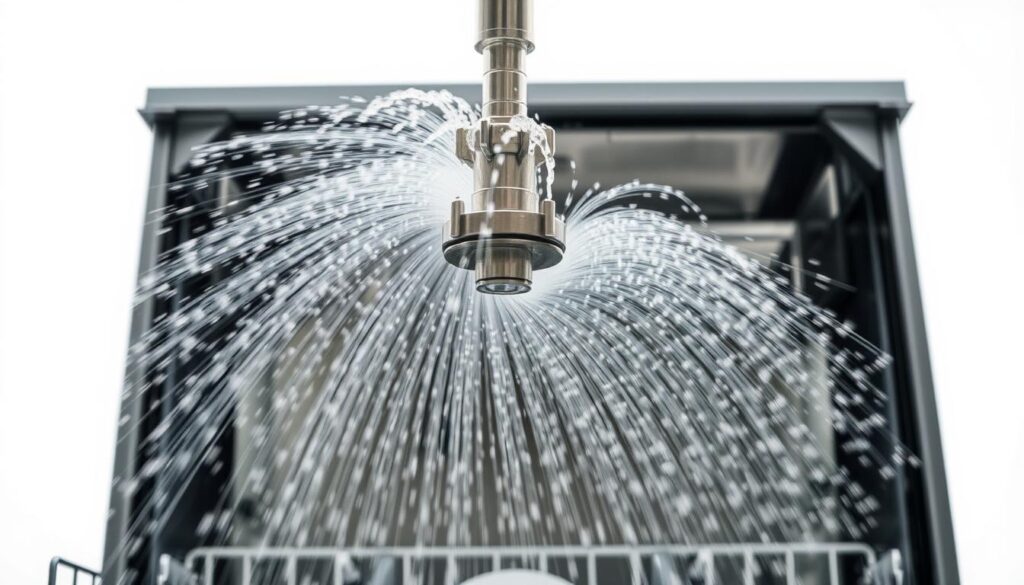
Assessing Water Flow and Identifying Blockages
If water is not coming out of some or all of the spray arm holes, and you can’t see any blockages that you can clear, it may indicate an internal blockage. In such cases, the spray arm likely needs to be replaced.
- Check if water flows freely through all holes.
- Identify any remaining blockages that need to be cleared.
- Assess whether the spray arm needs replacement based on the water flow test.
After testing and potentially replacing the spray arm, reinstall it in your dishwasher and run a cycle to verify that it rotates properly and distributes water effectively.
Dishwasher Spray Arm Not Spinning Fix: Circulation Pump Issues
Circulation pump issues can often be the root cause of a stationary spray arm in your dishwasher. The circulation pump is responsible for circulating water throughout the dishwasher, providing the necessary water pressure to rotate the spray arms.
If the circulation pump is faulty, it may not supply enough water pressure, resulting in the spray arms not spinning. Understanding how the circulation pump affects spray arm rotation is crucial to diagnosing the issue.
Pump-Related Problems
The circulation pump can fail due to wear-and-tear, blockages, or a damaged impeller. To identify if the circulation pump is the problem, you need to understand its role in the dishwasher system and how it affects the spray arms.
- The circulation pump generates water pressure that rotates the spray arms.
- Symptoms of circulation pump problems include weak or no spray arm rotation.
- Common causes of circulation pump failure include wear and tear, electrical issues, and physical damage.
To determine if your dishwasher’s circulation pump needs repair or replacement, you should inspect the pump and its components. A table summarizing the key points can help in understanding the relationship between the circulation pump and spray arm movement.
| Circulation Pump Status | Spray Arm Movement | Possible Cause |
|---|---|---|
| Functional | Spinning | Normal Operation |
| Faulty | Not Spinning | Wear-and-tear, Blockage, Damaged Impeller |
| Partially Functional | Weak or Intermittent | Reduced Water Pressure, Partial Blockage |
By understanding the role of the circulation pump and its impact on the spray arms, you can diagnose and potentially fix the issue causing your dishwasher’s spray arm not to spin.
Accessing and Checking the Circulation Pump
To access the circulation pump, you may need to remove the filter in the dishwasher sump. This allows you to inspect the pump for any blockages or debris that might be preventing the spray arms from rotating.
Locating the Pump
Typically, you can remove a small pump cover by pulling the tab that protrudes from it, giving you access to a portion of the pump. If the spray arms still won’t rotate after clearing debris, you may need to remove the front panel and kick plate to check the entire circulation pump. For more information on troubleshooting issues with your dishwasher, you can visit this page on common symptoms and fixes.
Inspecting the Pump Impeller
The pump impeller plays a vital role in your dishwasher’s ability to clean dishes effectively, so it’s essential to inspect it thoroughly.
Critical Examination of the Pump Component
Once you have accessed the pump, check for any debris that might be obstructing its operation. Be cautious of sharp objects like glass that may be lodged within the pump.
Next, verify that the impeller can be turned freely by hand. If it cannot, it likely needs replacement. Similarly, if there is any damage to the impeller, replacement is probably necessary.
| Inspection Criteria | Possible Issues | Recommended Action |
|---|---|---|
| Debris in the pump | Blockages preventing circulation | Clean out debris carefully |
| Impeller movement | Restricted or stuck impeller | Replace if cannot turn freely |
| Impeller condition | Damage to plastic or blades | Replace if damaged |
When inspecting the impeller, look for signs of wear or damage, such as cracks or broken blades. Any damage can significantly impact the circulation of water within your dishwasher, affecting its overall performance.
By carefully examining the pump impeller and addressing any issues found, you can restore your dishwasher’s efficiency and ensure your dishes are cleaned properly.
Checking Dishwasher Hoses for Blockages
If your dishwasher’s spray arms are still not spinning after checking the circulation pump, the issue might lie in the hoses. The hoses connected to the circulation pump may have a blockage that’s preventing the spray arms from receiving enough water pressure.
Inspecting Water Supply Lines
To inspect the hoses, you’ll need to access them, which may involve removing panels. Check the hoses for kinks, damage, or blockages. For more complex issues or if you’re unsure, consider consulting a professional, such as those specialising in dishwasher repair.
When to Replace Spray Arms or Pump Components
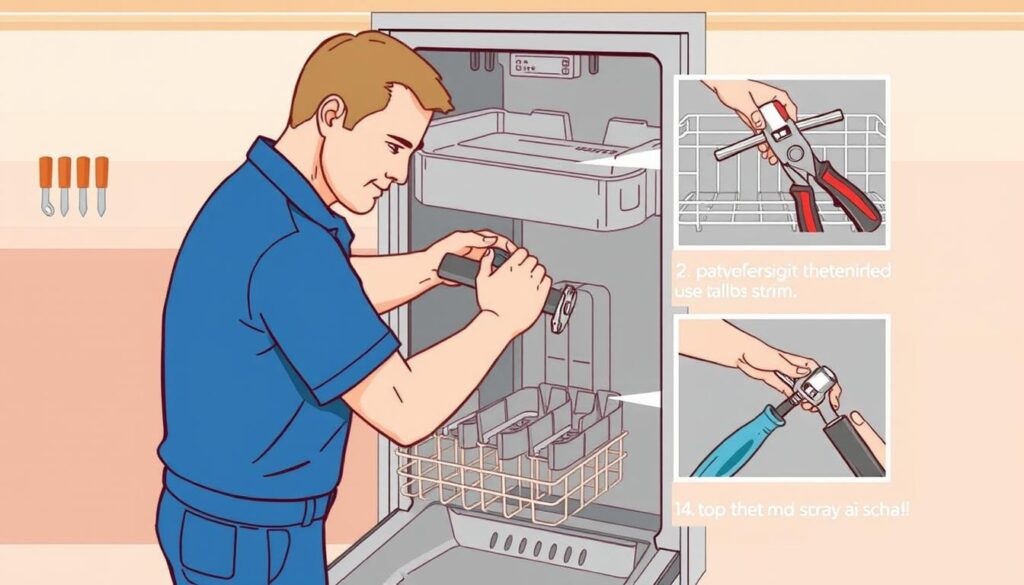
Replacement of spray arms or pump components is necessary when cleaning and repair are insufficient. If water is not coming out of any of the spray arm holes and you cannot see a blockage, it likely has an internal blockage and needs to be replaced.
Making the Decision to Replace Parts
To determine if your pump needs to be replaced, you can use a multimeter to test for continuity after removing it from the dishwasher. If the pump fails the continuity test, it will need to be replaced. Signs that indicate the need for replacement include permanent damage to spray arms, such as cracks or warping, and wear on impeller components.
Preventing Future Spray Arm Problems
To keep your dishwasher running efficiently, it’s crucial to maintain the spray arms. Regular maintenance can prevent blockages and ensure consistent performance.
Tips for Optimal Performance
One effective way to maintain your dishwasher’s spray arms is by running a cleaning cycle with white vinegar. Place a bowl filled with white vinegar upright in the upper rack of the dishwasher, splash some vinegar into the bottom, and fill the soap dish for good measure. Then, run the dishwasher empty on the hottest water setting without heated dry. This helps break up any mineral deposits and clean the inside of your dishwasher.
Regular maintenance routines can significantly reduce the risk of spray arm blockages. This includes checking for physical obstructions and ensuring proper loading techniques to prevent items from interfering with spray arm rotation.
- Run a monthly cleaning cycle with vinegar to prevent mineral buildup.
- Check water hardness and consider using a water softener if necessary.
- Regularly inspect spray arms for signs of wear or blockage.
By following these maintenance tips, you can ensure your dishwasher’s spray arms continue to function effectively, providing you with cleaner dishes and a more efficient dishwasher cycle.
Conclusion
With the right approach, you can easily troubleshoot and repair or replace faulty dishwasher spray arms. By reviewing the key steps outlined in this article, you’ll be able to diagnose issues with your dishwasher’s spray arms and take corrective action.
Regular maintenance is crucial to extend the life of your dishwasher and prevent future problems. Understand when to attempt DIY repairs and when to seek professional help to ensure optimal cleaning performance.
